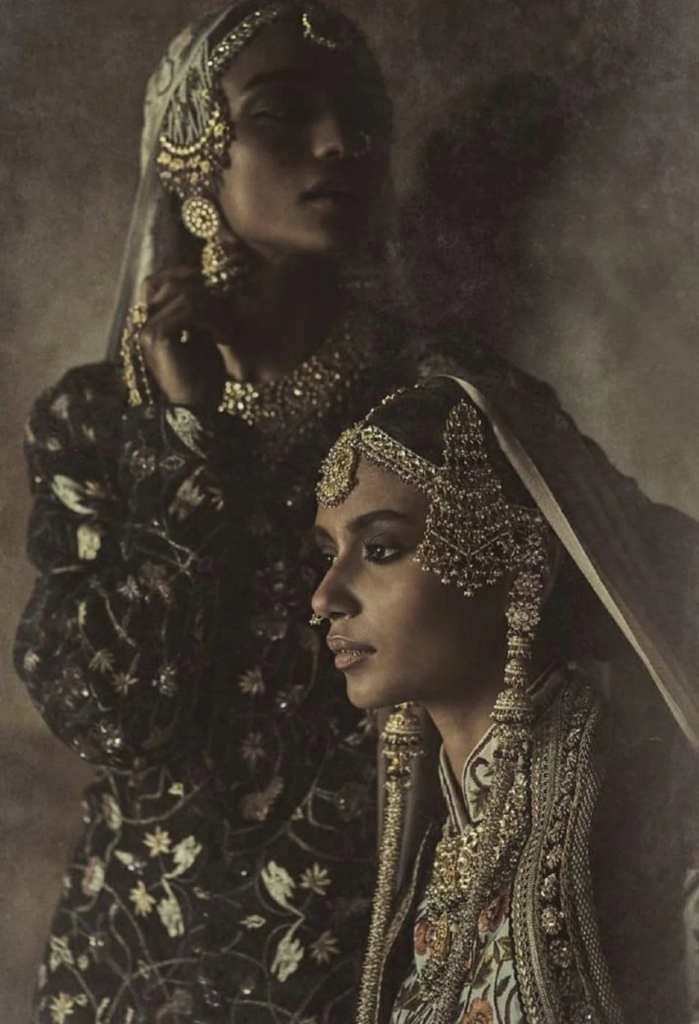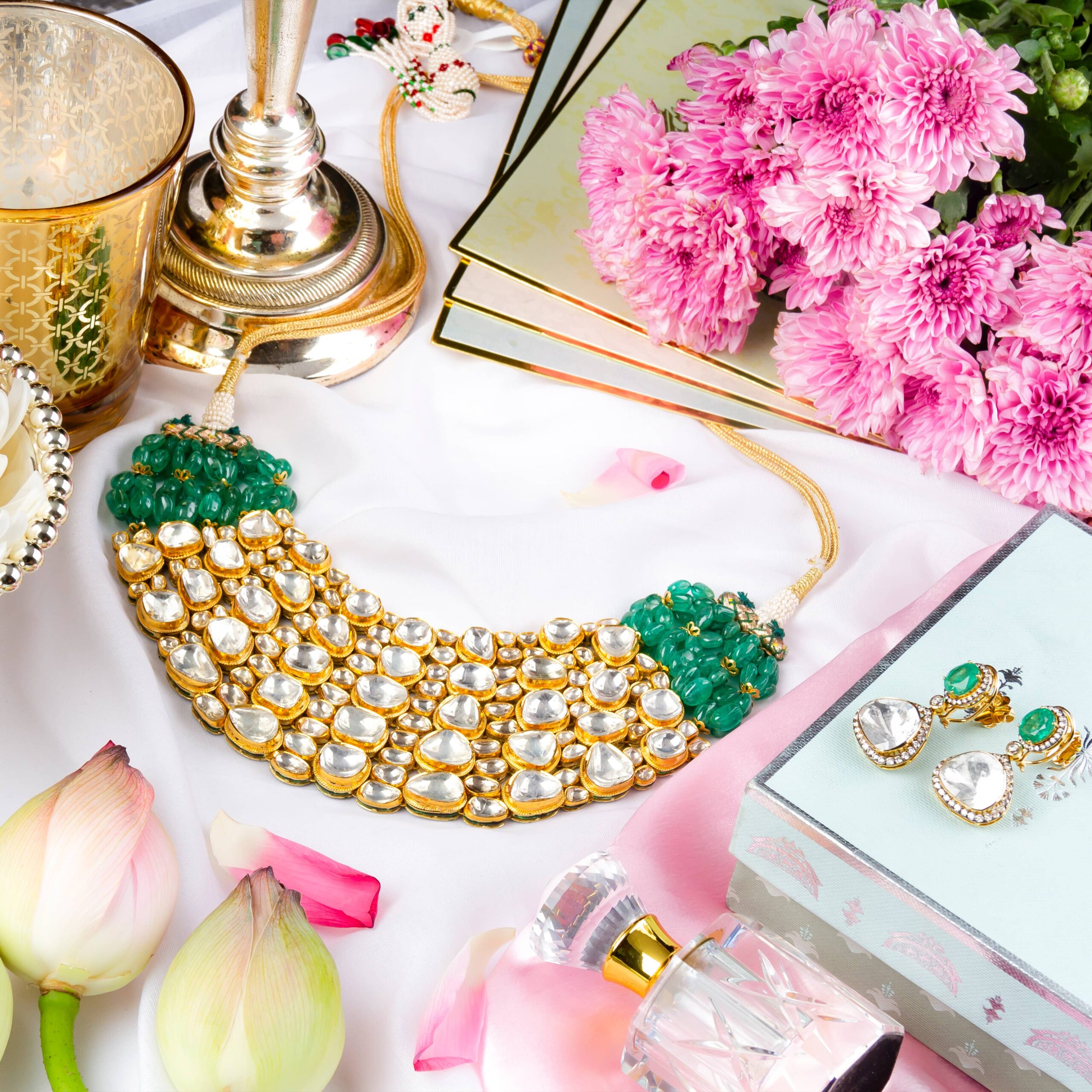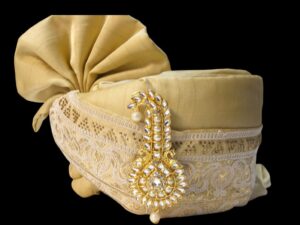Bridal jewellery holds a special place in Indian culture, symbolising the sacred bond of marriage and the wealth and status of the bride and her family. Over the centuries, bridal jewellery in India has evolved, influenced by regional customs, historical events, and modern trends. This article explores the evolution of bridal jewellery, from its ancient roots to contemporary designs, and highlights where to find the finest bridal jewellery in Dehradun, known for its exceptional craftsmanship.
1. Ancient Origins of Bridal Jewellery

The tradition of adorning brides with jewellery dates back to ancient India, where jewellery was considered an essential part of a woman’s identity. The earliest references to bridal jewellery can be found in the Vedic texts, where ornaments like bangles, earrings, necklaces, and anklets were described as symbols of prosperity, fertility, and protection.
In ancient India, bridal jewellery was crafted using gold, silver, and gemstones, which were believed to have protective and healing properties. Each piece of jewellery had a specific meaning and was worn for different reasons:
-
- Mangalsutra: The mangalsutra, a necklace made of black beads and gold, has been a crucial part of Hindu weddings since ancient times. It symbolizes the marital status of the bride and is believed to protect her from evil spirits.

-
- Kamarbandh: The kamarbandh, or waist belt, was worn by brides to enhance their figure and protect their womb. It was usually made of gold and adorned with precious stones.

-
- Maang Tikka: The maang tikka, worn on the forehead, is believed to protect the bride’s third eye and ensure her well-being. It is traditionally made of gold and studded with pearls or diamonds.
-
- Nath: The nath, or nose ring, was introduced to India by the Mughals and quickly became an essential part of bridal jewellery. It symbolizes purity and is often passed down as a family heirloom.

These traditional pieces of jewellery were not just ornaments but held deep cultural and spiritual significance. They were carefully crafted by skilled artisans, who passed down their techniques from generation to generation.
2. Medieval Influences on Bridal Jewellery

The medieval period in India was marked by the influence of various dynasties, including the Mughals, Rajputs, and Marathas, each of whom brought their unique styles and traditions to bridal jewellery.
-
- Mughal Influence: The Mughals introduced intricate designs and the use of precious gemstones like diamonds, emeralds, and rubies in bridal jewellery. They also popularised the art of Kundan and Polki, which involved setting uncut diamonds in gold. Mughal bridal jewellery was characterised by its grandeur and opulence, with heavy necklaces, chokers, and earrings becoming popular among the royal families.

-
- Rajput Influence: Rajput bridal jewellery was known for its bold and elaborate designs. Rajput brides adorned themselves with multiple layers of jewellery, including heavy necklaces, jhumkas (earrings), bangles, and anklets. The use of pearls and emeralds was common, and each piece of jewellery was designed to reflect the bride’s royal heritage.

-
- Maratha Influence: The Marathas, known for their simplicity and elegance, favored lightweight gold jewellery with minimal embellishments. Bridal jewellery in Maharashtra often included the nath, mangalsutra, and green glass bangles, which are still popular among Maratha brides today.

3. The Colonial Era and Its Impact on Bridal Jewellery
The colonial era brought about significant changes in Indian bridal jewellery. With the advent of British rule, Western influences began to seep into Indian culture, including jewellery design.
-
- Victorian Influence: The Victorian era introduced delicate and refined designs to Indian bridal jewellery. The use of diamonds and other precious stones became more prevalent, and new techniques like filigree and enameling were introduced. Victorian-style jewellery, with its intricate detailing and romantic motifs, became popular among Indian brides, especially in urban areas.
-
- Fusion of East and West: The colonial period also saw the fusion of Indian and Western styles in bridal jewellery. This blend of cultures led to the creation of unique designs that combined traditional Indian motifs with Western elegance. For example, Indian brides began to wear tiaras and brooches, which were not part of traditional Indian bridal attire.
-
- The Rise of Modern Jewellery: The early 20th century marked the beginning of the modern era in Indian bridal jewellery. With the decline of the princely states and the rise of the middle class, there was a shift towards more affordable and practical jewellery. Brides began to favor lighter, more versatile pieces that could be worn on multiple occasions.
4. Contemporary Trends in Bridal Jewellery
Today, bridal jewellery in India is a blend of tradition and modernity. While traditional pieces like the mangalsutra, nath, and maang tikka are still an integral part of bridal attire, modern brides are also embracing new trends and styles.
-
- Minimalist Designs: Contemporary brides are increasingly opting for minimalist designs that are elegant yet understated. Delicate necklaces, simple earrings, and dainty bracelets are popular choices for brides who prefer a subtle look.
-
- Customization: Customization has become a significant trend in bridal jewellery. Brides are now opting for personalized pieces that reflect their unique style and personality. Custom-made jewellery allows brides to choose their favorite designs, gemstones, and metals, making their bridal jewellery truly one-of-a-kind.
-
- Sustainable and Ethical Jewellery: With growing awareness about sustainability, many brides are choosing eco-friendly and ethically sourced jewellery. Recycled gold, conflict-free diamonds, and lab-grown gemstones are becoming popular choices among environmentally conscious brides.
-
- Fusion Jewellery: Fusion jewellery, which combines traditional and contemporary elements, is a favorite among modern brides. For example, a traditional Kundan necklace may be paired with a sleek diamond bracelet, or a maang tikka may be designed with a modern twist.
-
- Statement Pieces: While minimalist designs are trending, some brides still prefer bold and statement-making jewellery. Oversized chokers, layered necklaces, and elaborate earrings are popular among brides who want to make a grand entrance.
-
- Regional Influence: Despite the global influences, regional styles continue to play a significant role in bridal jewellery. Brides often choose jewellery that reflects their cultural heritage, such as the temple jewellery of South India, the polki jewellery of Rajasthan, or the pearl jewellery of Hyderabad.
5. Finding the Best Bridal Jewellery in Dehradun
Dehradun, nestled in the foothills of the Himalayas, is renowned for its rich tradition of jewellery craftsmanship. The city is home to some of the finest jewelers in India, offering an exquisite range of bridal jewellery that caters to both traditional and modern tastes. Here are some of the best jewelers in Dehradun:
-
- KundanMala Jewellers: Known for their exceptional craftsmanship and attention to detail, KundanMala Jewellers is a go-to destination for bridal jewellery in Dehradun. They offer a wide range of traditional and contemporary designs, including Kundan, Polki, and diamond jewellery. Whether you’re looking for a classic mangalsutra or a modern statement necklace, KundanMala Jewellers has something for every bride.
-
- Anand Jewellers: Anand Jewellers is one of the most reputed jewelers in Dehradun, known for their high-quality gold and diamond jewellery. Their bridal collection includes a variety of designs, from intricate traditional pieces to elegant modern styles. They also offer customization services, allowing brides to create personalized jewellery that reflects their unique style.
-
- Ganpati Jewellers: Ganpati Jewellers is another popular choice for bridal jewellery in Dehradun. They offer a stunning collection of gold, diamond, and Kundan jewellery, with designs that cater to both traditional and contemporary tastes. Their jewellery is known for its intricate detailing and superior craftsmanship.
-
- Mittal Jewellers: Mittal Jewellers is a trusted name in Dehradun, offering a wide range of bridal jewellery that combines traditional elegance with modern sophistication. Their collection includes everything from heavy gold necklaces to delicate diamond earrings, making them a one-stop-shop for all your bridal jewellery needs.
-
- Panchu Panna Jewellers: Specializing in traditional Indian jewellery, Panchu Panna Jewellers offers a beautiful collection of bridal jewellery that reflects the rich cultural heritage of India. Their designs are perfect for brides who want to embrace their roots while adding a touch of modernity to their look.
6. Conclusion
The evolution of bridal jewellery in India is a fascinating journey through time, reflecting the country’s rich cultural heritage and the changing tastes and preferences of brides. From the opulent designs of the Mughal era to the minimalist trends of today, bridal jewellery has continually evolved, blending tradition with modernity.
In Dehradun, the tradition of bridal jewellery continues to thrive, with some of the best jewelers in the city offering a diverse range of designs to suit every bride’s taste. Whether you’re looking for traditional Kundan jewellery or modern diamond pieces, the jewelers in Dehradun provide high-quality craftsmanship and exquisite designs that make every bride feel special on her big day.
As you embark on your journey to find the perfect bridal jewellery, remember to choose pieces that reflect your personality and style, while also honoring the rich traditions of Indian culture. With the wide range of options available, you’re sure to find the perfect jewellery to make your wedding day truly memorable.






